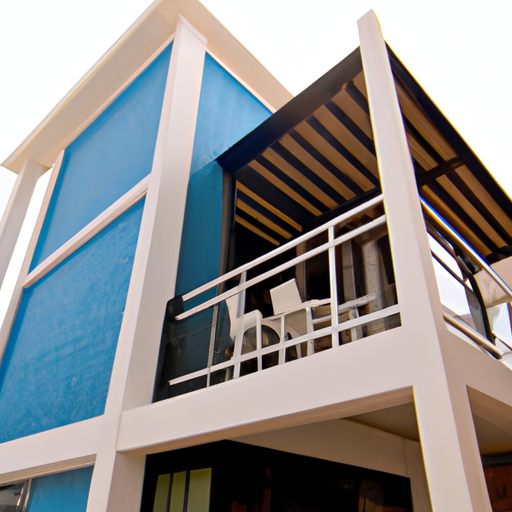Blending Timeless Charm and Contemporary Style: A Guide to Harmonious Home Architecture
The art of balancing traditional and modern elements in home architecture is a delicate dance that requires a keen eye for design, a deep understanding of history, and a strong sense of personal style. This harmonious blend of timeless charm and contemporary flair can create a truly unique and inviting living space that reflects the homeowner’s personality and taste. In this article, we will explore the various ways in which architects and designers can successfully merge the old with the new to create a cohesive and visually stunning home.
One of the most important aspects of blending traditional and modern elements in home architecture is understanding the historical context of the design. This means researching the architectural styles and features that were popular during the time period in which the home was built, as well as the materials and techniques that were used in its construction. By incorporating these elements into the design, architects can create a sense of continuity and authenticity that pays homage to the home’s heritage while still allowing for modern updates and conveniences.
Another key factor in achieving a harmonious balance between traditional and modern elements is the careful selection of materials. Using a mix of natural and man-made materials can help to create a visually interesting and dynamic space that feels both grounded in history and forward-thinking. For example, combining natural stone or brick with sleek metal or glass accents can create a striking contrast that highlights the best of both worlds. Additionally, using reclaimed or repurposed materials can add a layer of depth and character to the design, while also promoting sustainability and eco-friendliness.
Color and texture also play a significant role in blending traditional and modern elements in home architecture. By incorporating a mix of bold, contemporary colors with more muted, classic hues, designers can create a visually engaging space that feels both fresh and timeless. Similarly, using a variety of textures – such as rough, rustic wood alongside smooth, polished concrete – can add depth and interest to the design, while also helping to bridge the gap between old and new.
One of the most effective ways to create a harmonious blend of traditional and modern elements in home architecture is through the use of transitional design. This approach involves taking elements from both styles and combining them in a way that feels cohesive and balanced. For example, a transitional kitchen might feature traditional cabinetry and molding alongside sleek, modern appliances and fixtures. By incorporating elements from both styles, transitional design allows for a seamless integration of old and new, creating a space that feels both familiar and fresh.
Finally, it’s important to remember that the art of balancing traditional and modern elements in home architecture is ultimately a personal endeavor. Each homeowner will have their own unique vision for their space, and it’s up to the architect and designer to help bring that vision to life. By working closely with the homeowner and taking the time to understand their individual needs and preferences, architects can create a truly one-of-a-kind home that perfectly blends timeless charm and contemporary style.
In conclusion, the art of balancing traditional and modern elements in home architecture is a delicate and nuanced process that requires a deep understanding of history, a keen eye for design, and a strong sense of personal style. By incorporating elements from both styles, using a mix of materials and textures, and embracing transitional design, architects and designers can create a harmonious and visually stunning home that reflects the homeowner’s unique personality and taste.
Navigating the Fusion of Classic and Modern Design in Residential Spaces

The art of balancing traditional and modern elements in home architecture is a delicate dance that requires a keen eye for design and a deep understanding of the history and evolution of residential spaces. As homeowners seek to create living environments that reflect their personal tastes and lifestyles, architects and designers are increasingly tasked with the challenge of blending classic and contemporary styles in a harmonious and aesthetically pleasing manner. This fusion of old and new can result in a unique and timeless space that transcends trends and offers a sense of comfort and familiarity, while still embracing the innovations and advancements of modern design.
One of the key aspects of successfully navigating the fusion of classic and modern design in residential spaces is understanding the fundamental principles and characteristics of each style. Traditional architecture is often characterized by symmetry, proportion, and a sense of grandeur, with an emphasis on craftsmanship and attention to detail. Modern design, on the other hand, is typically defined by clean lines, open spaces, and a minimalist approach that prioritizes functionality and efficiency. By identifying the core elements of each style, architects and designers can begin to explore ways in which they can be combined and adapted to create a cohesive and balanced aesthetic.
In order to achieve a harmonious blend of traditional and modern elements, it is important to establish a clear vision and direction for the overall design. This may involve selecting a specific architectural style or period as a starting point, and then incorporating contemporary elements that complement and enhance the chosen theme. For example, a homeowner may wish to create a space that evokes the elegance and sophistication of a Georgian townhouse, while still incorporating modern conveniences and technologies. In this case, the designer might choose to retain the classic proportions and detailing of the original style, while introducing contemporary materials and finishes that provide a subtle nod to the present day.
Another approach to balancing traditional and modern elements in home architecture is to focus on the use of materials and textures. By carefully selecting and combining materials that have a rich history and timeless appeal, such as natural stone, wood, and metals, with more modern and innovative materials, such as glass, concrete, and steel, designers can create a dynamic and visually engaging space that bridges the gap between past and present. This can be particularly effective in spaces where the architectural envelope is predominantly traditional, as the introduction of contemporary materials can help to create a sense of contrast and tension that adds depth and interest to the overall design.
Color and lighting also play a crucial role in the successful fusion of classic and modern design in residential spaces. By using a restrained and sophisticated color palette that draws inspiration from both traditional and contemporary sources, designers can create a harmonious and unified aesthetic that feels both timeless and current. Similarly, the careful integration of modern lighting solutions, such as LED fixtures and smart home technology, can help to enhance the architectural features and details of a traditional space, while also providing the flexibility and convenience that modern homeowners demand.
Ultimately, the art of balancing traditional and modern elements in home architecture is about finding the perfect equilibrium between the comfort and familiarity of the past and the innovation and progress of the present. By carefully considering the unique characteristics and qualities of each style, and thoughtfully blending them together in a way that feels both cohesive and dynamic, architects and designers can create residential spaces that truly stand the test of time.
The Seamless Integration of Old and New: Mastering the Art of Mixed Architectural Elements
The art of balancing traditional and modern elements in home architecture is a delicate dance that requires a keen eye for design and a deep understanding of the history and culture of the space. This seamless integration of old and new is a testament to the skill and creativity of architects and designers who are able to master the art of mixed architectural elements. The result is a harmonious blend of styles that not only pays homage to the past but also embraces the future, creating a timeless and unique living space.
One of the key aspects of successfully integrating traditional and modern elements in home architecture is understanding the context in which the building is situated. This includes the historical and cultural background of the area, as well as the architectural styles that have been prevalent throughout its history. By taking these factors into consideration, architects and designers can create a design that is sensitive to its surroundings and respectful of its heritage.
In addition to understanding the context, it is also important to carefully select the materials and finishes that will be used in the construction of the home. This can be a challenging task, as it requires a balance between maintaining the integrity of the traditional elements while also incorporating modern materials and technologies. One approach to achieving this balance is to use materials that are similar in appearance to those used in the original construction, but with updated properties that make them more suitable for contemporary living. For example, reclaimed wood can be used to create a rustic, traditional feel while also being environmentally friendly and sustainable.
Another key aspect of integrating traditional and modern elements in home architecture is the use of scale and proportion. This can be achieved by carefully considering the size and placement of new additions or alterations to the existing structure. By maintaining a sense of balance and harmony between the old and new elements, architects and designers can create a cohesive and visually appealing design.
Transitional spaces are also an important consideration when blending traditional and modern elements in home architecture. These spaces, which can include hallways, staircases, and entryways, serve as a bridge between the old and new elements of the design. By thoughtfully designing these transitional spaces, architects and designers can create a smooth and seamless flow between the different styles, ensuring that the overall design feels cohesive and unified.
One of the most effective ways to achieve a successful integration of traditional and modern elements in home architecture is through the use of color and texture. By carefully selecting a color palette that complements both the traditional and modern aspects of the design, architects and designers can create a harmonious and visually appealing space. Similarly, the use of texture can help to create a sense of depth and dimension, adding interest and character to the design.
In conclusion, the art of balancing traditional and modern elements in home architecture is a complex and nuanced process that requires a deep understanding of the history and culture of the space, as well as a keen eye for design. By carefully considering the context, materials, scale, transitional spaces, and color and texture, architects and designers can create a seamless integration of old and new that results in a timeless and unique living space. This mastery of mixed architectural elements not only pays homage to the past but also embraces the future, ensuring that the home remains relevant and beautiful for generations to come.
Q&A
Question 1: How can one successfully blend traditional and modern elements in home architecture?
Answer: To successfully blend traditional and modern elements in home architecture, one should focus on incorporating key features from both styles, such as using traditional materials like wood and stone alongside modern materials like glass and steel, creating a harmonious balance between the two. Additionally, consider combining classic architectural elements like pitched roofs and arches with contemporary design features like open floor plans and large windows to create a unique and visually appealing space.
Question 2: What are some tips for choosing the right mix of traditional and modern elements for a home?
Answer: When choosing the right mix of traditional and modern elements for a home, consider the following tips:
1. Assess the existing architectural style of the home and its surroundings to determine which elements can be preserved or enhanced.
2. Identify the key features of both traditional and modern styles that appeal to you and can be incorporated into the design.
3. Prioritize functionality and comfort, ensuring that the blend of styles serves the needs of the occupants.
4. Use a consistent color palette and materials to create a cohesive look throughout the home.
5. Consult with an architect or designer experienced in blending styles to ensure a harmonious and well-executed design.
Question 3: What are some common challenges faced when balancing traditional and modern elements in home architecture, and how can they be overcome?
Answer: Some common challenges faced when balancing traditional and modern elements in home architecture include:
1. Striking the right balance: Ensuring that neither style dominates the other can be difficult. To overcome this, focus on creating a harmonious blend by incorporating a mix of materials, textures, and design features from both styles.
2. Preserving historical elements: When working with a historic home, it’s important to preserve its character while updating it for modern living. Collaborate with a preservation specialist to ensure that any renovations respect the home’s original architecture.
3. Achieving a cohesive design: Combining different styles can sometimes result in a disjointed appearance. To create a cohesive design, use a consistent color palette and materials throughout the home, and consider the overall flow and layout of the space.
4. Meeting building codes and regulations: When blending traditional and modern elements, it’s essential to ensure that the design meets all relevant building codes and regulations. Work with an architect or designer who is familiar with these requirements to ensure compliance.
Conclusion
In conclusion, the art of balancing traditional and modern elements in home architecture is a creative and dynamic process that requires a thoughtful approach to design. By carefully blending the best of both worlds, architects and homeowners can create unique, functional, and aesthetically pleasing living spaces that pay homage to the past while embracing the innovations of the present. This harmonious integration not only enhances the visual appeal of a home but also contributes to its overall comfort, sustainability, and adaptability to the changing needs of its inhabitants.


